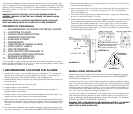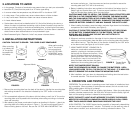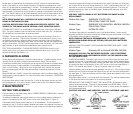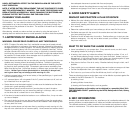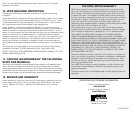
(included Longlife lithium battery is warranted for ten years) This alarm has a low bat-
tery monitor circuit which will cause the alarm to “chirp’” approximately every 30 - 40
seconds for a minimum of seven (7) days when the battery gets low. The chirp will
be accompanied by a flash of the Safety Light. Replace both batteries when this
condition occurs.
USE ONLY THE FOLLOWING 9 VOLT BATTERIES FOR SMOKE ALARM
REPLACEMENT.
Carbon Zinc Type: EVEREADY 216 OR 1222;
GOLD PEAK 1604P OR 1604S
Alkaline Type: EVEREADY 522; DURACELL MN1604, MX1604
GOLD PEAK 1604A
Lithium Type: ULTRALIFE U9VL
The Safety Light portion is powered by one (1) 9V alkaline battery. Under normal
(standby) conditions, the battery should last at least one year and provide 15 minutes
of illumination when the alarm is sounding.
NOTE: REGULAR TESTING IS RECOMMENDED. IF THE SAFETY LIGHT
APPEARS DIM DURING REGULAR TESTING, REPLACE BOTH BATTERIES
IMMEDIATELY.
USE ONLY THE FOLLOWING 9 VOLT ALKALINE BATTERIES FOR SAFETY LIGHT
REPLACEMENT
Alkaline Type: Eveready 522 or Duracell MN1604, MX1604
WARNING!! USE ONLY THE BATTERIES SPECIFIED. USE OF DIFFERENT
BATTERIES MAY HAVE A DETRIMENTAL EFFECT ON THE SMOKE ALARM
OR THE SAFETY LIGHT.
LAMP REPLACEMENT: The Safety Light has a 6.3 volt 250mA fuse type lamp (aver-
age life of 50 hours). If the Safety Light does not operate with a fresh alkaline battery,
replace the lamp. To replace the lamp, remove the alarm from the mounting bracket
by rotating the alarm in the direction of the “OFF” arrow on the cover (see Section 3,
Figure 1 for removal, and Section 3, Figure 5 if tamper resist pin is used).
Open the battery door and remove both batteries from the unit. Grip the lamp holder
handle with your thumb and finger (see Figure 6) and pull out the lamp holder assem-
bly (see Figure 7). Slide the old lamp out of the lamp holder and replace it with a new
lamp (see Figure 8).
Reinstall the lamp holder. It will snap easily into the base. Put working batteries back
in the alarm and remount the alarm on its mounting bracket.
REPLACE WITH THE CORRECT LAMP TYPE: Vanco #FTB 6 is available at most
radio/tv repair parts stores. The lamp is also available from KIDDE Safety, 1394 S.
Third Street, Mebane, NC 27302. Send $1.50 (check or money order) and request a
0918 replacement lamp.
CAUTION!! USE ONLY LAMP SPECIFIED. USE OF A DIFFERENT LAMP MAY
FIGURE 6 FIGURE 7 FIGURE 8
smoke alarm is desensitized by pushing the “HUSH” button on the smoke alarm
cover. If the smoke is not too dense, the alarm will silence immediately and “chirp”
every 30 -40 seconds for approximately 7 minutes. This indicates that the alarm is in
a temporarily desensitized condition. The smoke alarm will automatically reset after
approximately 7 minutes and sound the alarm if particles of combustion are still pres-
ent. The “HUSH” feature can be used repeatedly until the air has been cleared of the
condition causing the alarm. Pushing the test/reset button will end the hush peri-
od.
NOTE: DENSE SMOKE WILL OVERRIDE THE HUSH CONTROL FEATURE AND
SOUND A CONTINUOUS ALARM.
CAUTION: BEFORE USING THE ALARM HUSH FEATURE, IDENTIFY THE
SOURCE OF THE SMOKE AND BE CERTAIN A SAFE CONDITION EXISTS.
FLASHING LED LIGHT: This smoke alarm is equipped with a flashing red indicator
light. The light is located under the test button and will flash every 30 - 40 seconds
to indicate that the smoke alarm is receiving power.
TESTING: Test by pushing the test button on the cover and holding it down for a
minimum of 2 seconds. This will sound the alarm if all the electronic circuitry, horn,
and battery are working. When the alarm sounds, the Safety Light will illuminate. If
no alarm sounds and the Safety Light does not illuminate, the unit has defective bat-
teries or other failure. DO NOT use an open flame to test your alarm, you could dam-
age the alarm or ignite combustible materials and start a structure fire.
TEST THE ALARM WEEKLY TO ENSURE PROPER OPERATION. Erratic or low
sound coming from your alarm may indicate a defective alarm, and it should be
returned for service (see Section 11).
5.NUISANCE ALARMS
Smoke alarms are designed to minimize nuisance alarms. Cigarette smoke will not
normally set off the alarm, unless the smoke is blown directly into the alarm.
Combustion particles from cooking may set off the alarm if the alarm is located close
to the cooking area. Large quantities of combustible particles are generated from
spills or when broiling. Using the fan on a range hood which vents to the outside
(non-recirculating type) will also help remove these combustible products from the
kitchen.
Model 0918K has a “HUSH” control that is extremely useful in a kitchen area or other
areas prone to nuisance alarms. For more information refer to Section 4, OPERATION
AND TESTING.
If the alarm does sound, check for fires first. If a fire is discovered, get out and call
the fire department. If no fire is present, check to see if one of the reasons listed in
Section 2 may have caused the alarm.
6.MAINTENANCE
BATTERY REPLACEMENT
If tamper resist pin has been used, refer to TAMPER RESIST LOCKING PIN in Section
3 for removal instructions.
To replace the batteries, remove the alarm from the mounting plate by rotating the
alarm in the direction of the “OFF” arrow on the cover (see Section 3, Figure 1).
The Model 0918K Smoke Alarm uses two (2) 9 volt batteries. The smoke alarm is
powered by one (1) 9V lithium battery (alkaline and carbon zinc batteries may also be
used). A fresh lithium battery will last for one year under normal operating conditions




